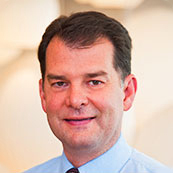Treatments for Bone Disorders and Malformations
Understanding bone biology through the discovery of osteogenic proteins derived from the study of craniosynostosis
Technology Overview
 Dr. Michael Cunningham
Dr. Michael Cunningham
Craniosynostosis, the premature fusion of the skull bones, is a significant medical and dental health issue. Dr. Michael Cunningham is investigating the molecular and developmental causes of isolated and hereditary craniosynostosis syndromes, with the goal of understanding what drives premature bone fusion. Using mesenchymal stem cells created from cell lines derived from surgical bone samples of craniosynostosis patients and RNA sequence data, Dr. Cunningham is evaluating the role of differential gene expression and genetic variation in the pathogenesis of the disease.
In addition to identifying causal mutations in craniosynostosis, this work is aimed at gaining an understanding of the biology of bone growth and how disease disrupts the maintenance of normal bone development. Using differential gene expression data and studies on the mechanobiology of osteoblasts, Dr. Cunningham is focused on identifying factors that affect bone growth. Recently, he and collaborators have identified a relationship between insulin growth factor 1 (IGF1) activation and changes in cellular contractility and migration in osteoblasts derived from craniosynostosis patients. Genetic variant analysis has demonstrated that genes with mutations that cause syndromic forms of craniosynostosis are more likely to harbor variants predicted to be damaging in single suture forms.
The discovery of osteogenic proteins may have important therapeutic implications for the treatment of fractures, osteoporosis, bony overgrowth and in the management of surgical wounds. Ultimately, it may be possible to develop therapeutics to treat bone disorders and congenital abnormalities or for use as adjuvants in surgical procedures involving the need to regrow bone or modulate the rate of bone growth. Dr. Cunningham is interested in potential industry collaborations where his expertise in bone biology would contribute to the identification of proteins involved in bone formation and the regulation of bone growth, as well as in proteins with potential clinical utility in the treatment and management of bone disorders and malformations.
Stage of Development
- Pre-clinical in vitro
- Pre-clinical in vivo
Partnering Opportunities
- Collaborative research opportunity
- Sponsored research agreement
- Tissue sample access
- Consultation agreement
Publications
- Gilbert JR, Losee JE, Mooney MP, Cray JJ, Gustafson J, Cunningham ML, Cooper GM. Genetic associations and phenotypic heterogeneity in the craniosynostotic rabbit. PLoS One. 2018 Sep 20;13(9):e0204086. doi: 10.1371/journal.pone.0204086. eCollection 2018. PubMed PMID: 30235265.
- Gustafson JA, Park SS, Cunningham ML. Calvarial osteoblast gene expression in patients with craniosynostosis leads to novel polygenic mouse model. PLoS One. 2019 Aug 23;14(8):e0221402. doi: 10.1371/journal.pone.0221402. eCollection 2019. PubMed PMID: 31442251.
- Al-Rekabi Z, Cunningham ML, Sniadecki NJ. Cell mechanics in craniosynostosis ACS Biomat Sci Engr ACS Biomater. Sci. Eng., 2017, 3: 2733–2743.
- Clarke CM, Fok VT, Gustafson JA, Smyth MD, Timms AE, Frazar CD, Smith JD, Birgfeld CB, Lee A, Ellenbogen RG, Gruss JS, Hopper RA, Cunningham ML. Single suture craniosynostosis: Identification of rare variants in genes associated with syndromic forms. Am J Med Genet A. 2017. [Epub ahead of print] PubMed PMID: 29168297.
- Al-Rekabi Z, Wheeler MM, Leonard A, Fura AM, Juhlin I, Frazar C, Smith JD, Park SS, Gustafson JA, Clarke CM, Cunningham ML, Sniadecki NJ. Activation of the IGF1 pathway mediates changes in cellular contractility and motility in single-suture craniosynostosis. J Cell Sci 2016; 129: 483-491.
- Park SS, Beyer RP, Smyth MD, Clarke CM, Timms AE, Bammler TK, Stamper BD, Mecham BH, Gustafson JA, Cunningham ML. Osteoblast differentiation profiles define sex specific gene expression patterns in craniosynostosis. Bone. 2015; 76:169-176.
- Homayounfar N, Park SS, Afsharinejad Z, Bammler TK, MacDonald JW, Farin FM, Mecham BH, Cunningham ML. Transcriptional analysis of human cranial compartments with different embryonic origins. Arch Oral Biol 2015; 60: 1450-1460.
- Stamper BD, Mecham B, Park SS, Wilkerson HW, Farin FM, Beyer RP, Bammler TK, Mangravite LM, Cunningham ML. Transcriptome correlation analysis identifies two unique craniosynostosis subtypes associated with IRS1 activation. Physiol Genomics. 2012; 44(23):1154-1163.
- Stamper BD, Park SS, Beyer RP, Bammler TK, Farin FM, Mecham B, Cunningham ML. Differential expression of extracellular matrix-mediated pathways in single-suture craniosynostosis. PLoS One. 2011; 6(10):e26557. PMCID: PMC3197523.
Learn More
To learn more about partnering with Seattle Children’s Research Institute on this or other projects, email the Office of Science-Industry Partnerships.
